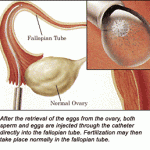Articles in the Artificial insemination Category
Artificial insemination, GIFT procedure »
Gamete Intra-Fallopian Transfer (GIFT) is a procedure in which the eggs are mixed with sperm and the mixture is then injected into the Fallopian tube. It is suitable for women who have at least one healthy Fallopian tube. The aim of GIFT is to allow fertilization to occur in the right place and implantation at the right time.
There are selected groups of patients to whom gamete intra-Fallopian transfer (GIFT) is recommended.• Couples with unexplained infertility.
• Women with minimal endometriosis.
• Men with infertility problem (not severe).
• Couples who have had failed …
Artificial insemination, IVF procedure »
Since the birth of Louise Brown in 1978, there has been a steady improvement in success rates of IVF treatment. The pregnancy rates vary between IVF clinics, and from time to time within the same clinic. The success of individual IVF clinics may be found in league tables published by HFEA. The overall live birth rate per treatment cycle is about 20%. There are many factors that may affect success rates.
The overall live birth rates for IVF in the United Kingdom have improved from last year from 20.4%. to 21.6%. …
Artificial insemination, IVF procedure »
For some couples undergoing IVF, one of the most significant ethical issues they may face is the fate of the surplus embryos.
Following embryo transfer, any remaining viable embryos are then cryopreserved (frozen) for later transfer. Not all embryos are suitable for freezing. The embryos can be frozen at the pronucleate, early cleavage or blastocyst stage. Overall about 50% of frozen embryos survive the thawing process. In the United Kingdom, the embryos can be frozen for up to 10 years with the intent of thawing and transferring them at a later …
Artificial insemination, IVF procedure »
The embryo replacement (embryo transfer) procedure is quite simple and usually pain free. It may cause minimal discomfort and no anesthetic is used, although some women may need sedation or occasionally a general anesthetic. The male partner is usually invited to attend the procedure. The couple may also be able to view the embryos through a monitor before the embryos are replaced.
Some couples are concerned that their eggs, sperm or embryos may mix up with that of other couples. The probability of this happening in a good centre is very …
Artificial insemination, IVF procedure »
Pain. The patient may experience pain. It is not unusual for women to experience some abdominal or pelvic pain. A hot water bottle or painkillers are often helpful. However, if the pain is severe, or persists, then you should consult your doctor.
Bleeding. The patients may have to wear panty liners for a day or two following egg collection. Any bleeding should be minimal and dark or brown in colour. If bleeding is severe or bright red then consult your doctor.
Nausea and vomiting. The patient may experience nausea or vomiting for …
Artificial insemination, IVF procedure »
There are several aims when monitoring the treatment cycle. These include: checking the development of follicles and lining of the uterus, to adjust the dose of the drugs if necessary and to time the hCG injection. Each patient is different, so the ovarian response varies between patients both in the number of follicles produced and the speed at which they mature. On average, you need to attend the clinic for two or three visits and occasionally more to see how well you have responded to the injection and adjust the …
Artificial insemination, IVF procedure »
A number of different drugs and protocols are used in IVF treatment. Because the treatment is individualized, a couple may find out that their drugs and protocols differ from other couples. This is quite normal. The duration of treatment also varies with the drug regimen and ranges from 2-4 weeks. During the treatment, the patients usually attend the clinic for about 2-4 visits for monitoring.
Some of the commonly used drugs include:
• Clomip
• hene tablets and hCG
• FSH and/or hMG and hCG
• GnRh analogues (agonist or antagonist) and FSH or hMG …
Artificial insemination, IVF procedure »
Preliminary testing. When attending an IVF clinic for the first time, the doctor will conduct a consultation. He or she will review in depth the past medical history, conduct physical and internal examination and your doctor may perform a ‘dummy’ embryo transfer to make sure there is no technical problems with the procedure. The doctor may order some investigations before proceeding with treatment.
These usually include:
• Semen analysis to check for sperm number, swimming ability, shape, and survival. . For men who have difficulty in producing semen samples on demand, the …
Artificial insemination, IVF procedure »
Conventional or standard IVF treatment involves the administration of fertility drugs, monitoring of the cycle, collection of eggs, mixing eggs and sperm together outside the woman’s body in a culture dish or test-tube. Any resulting embryos are left to grow and the best 2-3 embryos are then transferred into the woman’s womb. Any remaining embryos of good quality may then be frozen for future use. In the United Kingdom a maximum of three embryos are replaced.
IVF cycle. The diagram below summarises the IVF cycle.
The original indication for IVF was tubal …
Artificial insemination, GIFT procedure »

In patients undergoing the gamete intra-Fallopian transfer (GIFT) procedure, a prospective study was perfonned to establish the predictive value of attempting in-vitro fertilization (IVF) using extra oocytes obtained at laparoscopy and also the value of transferring the resulting embryo(s), in conjunction with GIFT, in the same treatment cyde. The GIFT procedure was performed in 50 treatment cycles involving 43 patients, of whom 20 have achieved clinical pregnancy with an overall success rate of 40% per treatment cycle. In 38 of these patients, one or more extra oocytes were available and …